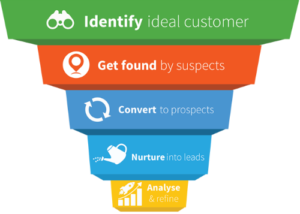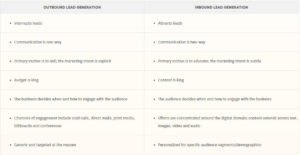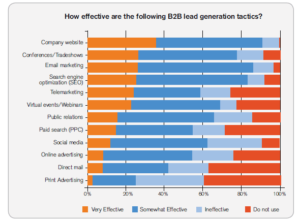Now that you have a business, how do you sell your products or services to customers? How do you get customers to know about your services and solutions, and educated them about using those? Do you even know who your customers are, and where you could find a good number of potential buyers in a marketplace? If not, this read this primer on Lead Generation.
This primer will give an idea on the concept of Lead Generation and the various ways of generating leads.
Who’s a Lead?
Now, a lead is a person who has indicated interest in your company’s product or service in some way, shape, or form. A lead is a prospect that can turn into a paying customer in the future, given proper Marketing and Sales efforts are employed.
What is Lead Generation?
HubSpot defines Lead Generation as “The process of attracting and converting strangers and prospects into someone who has indicated interest in your company’s product or service. Some examples of lead generators are job applications, blog posts, coupons, live events, and online content.”
In the words of TechTarget, “Lead generation is the use of a computer program, a database, the internet, or a specialized service to obtain or receive information for the purpose of expanding the scope of a business, increasing Sales revenues, looking for a job or for new clients or conducting specialized research. Leads can consist of the names and addresses (or e-mail addresses) of individuals, corporations, institutions or agencies. Lists of leads can be gathered or filtered from targeted databases such as telephone and Internet directories.”
“Lead Generation describes the Marketing process of stimulating and capturing interest in a product or service for the purpose of developing Sales pipeline.” – Marketo
BusinessDictionary defines it as the “Process of collecting names and contact information about qualified prospects which will be contacted by the Salespeople for generating orders. It usually involves a direct response to Advertising and Telemarketing.”
Read Also: Six Ways Brands Can Increase Lead Generation in 2019
To sum it up, we can describe Lead Generation as a process that identifies probable customers for your business, gets them to show interest in your offerings, and collects useful data. The data can be in the form of names, e-mail IDs, phone numbers, or organization’s name, etc., which can then be used to contact the prospects, educate them, and nurture them to be able to qualify them as Sales Qualified Leads (SQL). The SQLs can then be passed on to the Sales team for further follow-ups and converting them into customers.
 So, if 100 people visit your website and 10 of them submit their details via a pop-up or registration link, these 10 can be classified as leads as they have shown interest in one or other of your products/services. If you meet 20 people at a conference and five of them share their visiting cards or just their phone numbers, those five are leads for your business who need engaging and nurturing to be converted into customers immediately or later.
So, if 100 people visit your website and 10 of them submit their details via a pop-up or registration link, these 10 can be classified as leads as they have shown interest in one or other of your products/services. If you meet 20 people at a conference and five of them share their visiting cards or just their phone numbers, those five are leads for your business who need engaging and nurturing to be converted into customers immediately or later.
What are the channels of Lead Generation?
Primarily, there are two channels of Lead Generation – Inbound and Outbound.
Marketo defines Inbound Lead Generation as “The process of helping potential customers find your company—often before they are even looking to make a purchase—and then turning that early awareness into brand preference, and ultimately, into leads and revenue.”
As per Forrester, buyers seek out three pieces of content about a vendor for every one piece sent by a marketer, and for every one piece sent by Sales. This makes it imperative to make the buyers find you, rather than getting to them with intrusive means of advertising.
Inbound Lead Generation involves constructive means of educating customers with a well-planned content strategy. Here, you drive them to find your business by means of quality content and SEO, websites, blogs, social media, e-mails, and webinars.
Outbound Lead Generation, on the other hand, involves reaching out to masses that may or may not be interested in your offering. The most common methods of Outbound Marketing include display ads, direct mails, PPC ads, events, and content syndication.
While Email Marketing is mostly considered as an outbound activity, it actually falls into both the channels. Email Marketing can be used to reach out to leads that have previously opted-in for your blog updates or registered for a product demo; e-mailing them is part of an inbound marketing campaign. But buying a database of leads from a third-party and mass e-mailing is an outbound method which is more spammy and generic. No wonder Outbound leads cost 39% more than inbound leads.
 Image source: FreshSales
Image source: FreshSales
IDG carried out a survey to ascertain which methods of Lead Generation worked best for companies. It was found out that websites, conferences/tradeshows, and email marketing proved to be the best channels of communication, while print advertising and direct mail performed the worst.
 The three most commonly used B2B lead generation strategies are email marketing (78%), event marketing (73%), and content marketing (67%)
The three most commonly used B2B lead generation strategies are email marketing (78%), event marketing (73%), and content marketing (67%)
What metrics to track?
As part of your Lead Generation efforts, it is necessary to keep track of a few metrics that matter to your business. Some of the common Lead Generation metrics that companies track include:
Performance Metrics:
- Click Through Rate (CTR) – Tells you how many visitors are clicking on a link in your ad creative, landing page, or e-mail.
- Conversion Rate – A measure of how many visitors are performing a specific intended action like filling out a form, opting-in for blog updates, product demos, etc.
- Return on Investment (ROI) – It is a measure of how much money you have made with an initial investment. E.g., if you make $18 off each lead, and had initially invested $10 on acquiring per lead, your ROI will be 80%
- Time to Conversion – The time taken to convert a visitor into a verified lead.
Cost Metrics: Cost per Click (CPC), Cost per Mille (CPM), and Cost per Lead are the three most important metrics that fall under this category. They provide insights into the amount you are spending in acquiring each click via a paid advertisement campaign or if you are buying impressions via display ads.
The average cost of a B2B sales lead differs by industry. Healthcare leads cost the highest ($60/lead) followed by business/finance ($43/lead). Leads for Marketing products/services and technology are at the low-end ($32/lead and $31 per lead respectively).
Channel Metrics: Are you getting most of the traffic by website SEO, PPC ads, or by social media? Channel metrics provide insights into the performance of various channels/media employed for your Lead Generation efforts. So, checking for metrics like Lead Generation rate by channel and Month-to-date (MTD) channel goals is vital for marketers to optimize their spending on campaigns.
As a result of tracking channel metrics, you would be able to decide which channels to invest more resources in order to attain better ROI.
Read Also: How to Analyze Your Lead Generation Form Using Google Tag Manager




















